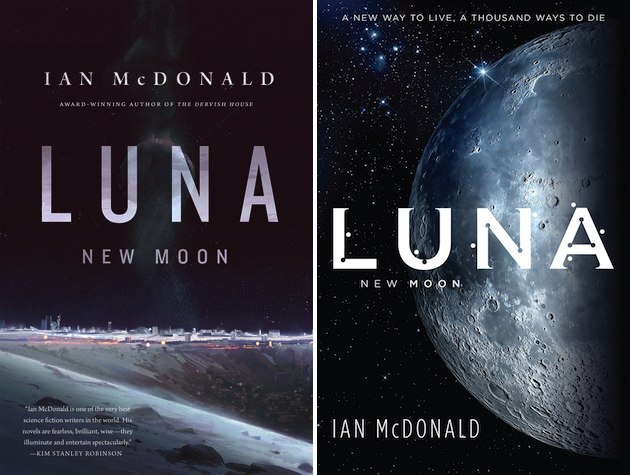I like details. Little things tell me everything about people, their society, their hopes and fears, the sky above them, the rock beneath them.
When I began writing Luna, I knew I would be building a world from scratch, but also one that adhered to the constraints of the physical realities of the moon. The Moon may have been Heinlein’s Harsh Mistress but we’ve learned a lot about Lady Luna since and she’s got leaner and meaner. A lot meaner. I wanted those facts to shape the world and lives of my characters, from low gravity to moon dust, which is seriously nasty stuff. I suppose it’s a “hard science fiction” book—though that’s an expression I hate. Hard science technically shapes the lives, loves, jealousies and ambitions of every one of my moon’s one point seven million citizens.
That’s where the Martinis come in. Booze, sex and getting off your head. These are fundamentals to the human species; nail them and you have a way into a world. What do you drink on the Moon? To me, that was an important question, and answering it opened up windows on every aspect of my created world.
Wine? It would be criminal to dedicate large percentages of rare carbon and water to grow a crop that doesn’t really have any other purpose than to produce booze.
Beer? Even worse. Barley, wheat and rice are inefficient crops—they succeed because of the space the surface of our planet affords them. Agricultural space is limited on the moon—building surface farms risks exposure to radiation and constant crop (and pest) mutations. So; no beer, but also little grain. Rice, wheat, flour are luxury foods.
But: spirit alcohol. Yes! You can make it from anything. Vodka and gin! Liquor opened up an entire world for me. My moon is a cocktail culture. The underground cities run on three different time zones so it’s always Happy Hour somewhere. The Cortas have their own signature cocktail; the Blue Moon. (I tried it, oh my beloveds. When I write a book, I sink deep into the mindset of the characters—it’s like method acting. I have become a real gin connoisseur/bore. My favourite? The light and fragrant Monkey 47 from the Black Forest in Germany. I do it for you, dear readers.)
And so, Dior. Because when you picture a Martini glass, you picture it in the gloved hand of Audrey Hepburn. And then I had it all. I didn’t want a Moon of people in coveralls and shorts and tank tops—these are people who have mastered 3D printing. If you can print clothes, why not in the style of one of the most elegant eras in fashion history? The 1950s. Dior and Balenciaga, Balmain and Jacques Fath.
That’s how I world-build. Cocktails and circle dresses.
The perfect Martini? Gin, of course. A good London gin, nothing too fancy. Chill the glass, be generous. Stir ten times (never shake) and add homeopathic levels of Martini Bianco. One olive, speared. Chin chin!
This article originally appeared on the Tor/Forge blog on September 8, 2015 and was published on Tor.com September 11, 2015.
Read an excerpt from Luna: New Moon here on Tor.com!
Ian McDonald is a British science fiction novelist, living in Belfast. His latest novel, Luna: New Moon is the first in a exciting new near-future series—available from Tor Books (US) and Gollancz (UK).












Luna new moon is in my to be read pile at home right now. I don’t drink often but the description sounds just lovely.
I just finished the audiobook version, which was fantastic. I cannot recommend this book enough
I do like the idea that God (and/or the Author) lives in the details, though I am less certain that a “3-martini lunch” circumstance would, perforce, foster a Mad Men culture. But, Hepburn! Dior! Why not?
And, yes to spirit alcohol, since it only requires the preferred sf vegetable (the potato, ala The Martian), but it also can get by with just the peelings, which would be a lot easier to divert than the whole food items themselves. Gin, though, is going to require access to juniper berries, which could be imported from Earth without too much trouble.
The question isn’t just about what is easy to grow on the moon, or in space.
It is also about what things need to be grown in order to ensure that the local population has a locally grown, reasonably balanced, diet which provides a generous source of the calories needed to do their work.
Oxygen is another issue. Plants create it, animals consume it. Food production would need to be oriented towards optimized oxygen maintenance.
Can you make distilled alcohol from “anything”? Yes, provided that anything can also be used to make an un-distilled alcohol. The process of distilling doesn’t suddenly make it reasonable to grow a crop that isn’t also part of the eaten diet, just for the sake of having alcohol.
Are fruits agriculturally intensive? Yes. But they are also very good sources of the vitamins needed to prevent deficiency diseases, as well as of calories through fruit sugars. Wines and ciders (fermented fruit juice, grape or other fruit) are a bonus.
Are grains crops that demand a lot of space? Yes, because we eat a lot of them. But they are also the basis of the most essential agricultural human diet, calories from carbohydrate crops, supplemented by smaller amounts of other foods (legumes, meats, fruits, vegetables, dairy) to provide other basic nutrients.
What would settlers on the moon use as their source of bulk calories? Grains aren’t ideal in the abstract, but what is there that is better? You might use potatoes as your basic starch, or perhaps some other plant that functions as a pseudo-grain, in dietary terms, such as buckwheat or quinoa.
Meats would be the real luxury, not grains. A food that you have to feed other food to, in order to obtain it. A food which consumes, rather than creates, breathable oxygen. Particularly since hunting would not be an option on the moon, all meat would have to be raised.
(Except, perhaps, if rodents or other pests managed to get there, in which case killing them off would be necessary, and being able to recover even a small proportion of the calories they stole from agriculture would be beneficial. Look for an early moon/space traditional dish being a stew of whatever plant-foods are most easily and abundantly grown, with a tiny amount of meat from mice, rats, or whatever other sources of protein make pests of themselves.)
***
I’d expect alcohol on the moon to be based on whatever is grown as a staple starch, plus, perhaps, things grown to provide oxygen but not otherwise edible, if they can figure out how to ferment them into something safe. A beer or pseudo-beer being the first option, as a gruel starch is allowed to ferment and then consumed. Much as early Egyptian beer is a strained, fermented grain gruel.
Since the technology of distilling would be known, the distilled version of the same starch source would be second basic alcohol. Distilling concentrates alcohol, but it is also wasteful, as un-fermented starch calories are discarded, and energy is needed for the distilling process.
Plus, since fermenting produces carbon dioxide, I’d expect it to be tracked the way meat production would be tracked, as an oxygen-consuming secondary food source. People, being people, would still want alcohol and meat. But there would need to be strong social controls against excess consumption of oxygen-intensive foods and drinks.
The same goes for flavoring alcohol. Does it make sense to grow juniper on the moon? No? Then juniper flavored gin will be a rare, imported luxury. Even locally fermented and distilled alcohol flavored with juniper will be a luxury dependent on an expensive import. The flavorings chosen for the local drinks will likely be new, and likely be based on things already being grown, as food, as oxygen producers, or as plants that can easily be grown locally for spice/flavorings. (Perhaps mint, basil, etc? an oxygen producing algae with an interesting taste?)
Don’t forget about Moon Zero Two’s Pampas Punch!